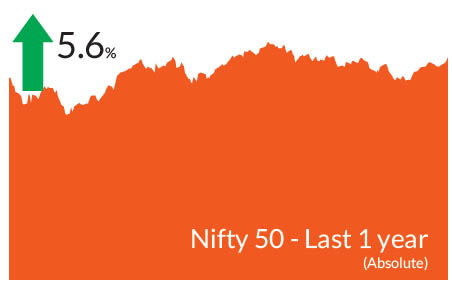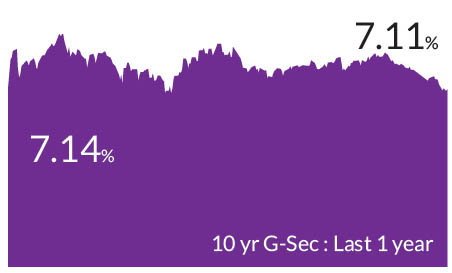► Equity market valuations are broadly reasonable adjusted for the cyclical low in earnings and
potential for revival going forward.
► We remain bullish on equities from a medium to long term perspective.
► Investors are suggested to have their asset allocation plan based on one's risk appetite and future goals in life.
► We remain bullish on equities from a medium to long term perspective.
► Investors are suggested to have their asset allocation plan based on one's risk appetite and future goals in life.


► Yield curve flat - Duration plays can be played in the 2-4 year segment.
► Peaking interest rates imply capital gains opportunities now become focal point of active fund management.
► Spreads between G-Sec/AAA & SDL/AAA have seen some widening.
► Credits continue to remain attractive from a risk reward perspective give the improving macro fundamentals.
► Peaking interest rates imply capital gains opportunities now become focal point of active fund management.
► Spreads between G-Sec/AAA & SDL/AAA have seen some widening.
► Credits continue to remain attractive from a risk reward perspective give the improving macro fundamentals.
Indian markets staged a strong recovery last month, as markets
digested full year earnings & sentiment turned favourable. S&P BSE
Sensex & NIFTY 50 ended the month up 3.6% & 4.1% respectively.
NIFTY Midcap 100 & NIFTY Small cap 100 outperformed their large
cap peers, up 5.9% & 7.4% respectively. FPI's continued adding to Indian
equities with a net purchase of Rs 11,600 Cr for the month of April
2023.
► Inflation Softens, Commodities & INR stable: Inflation trajectory in India has seen a gradual fall aided by softer commodity prices and monetary policy. March WPI inflation moderated sharply to 1.3% (February: 3.9%). Improvements in the external sector have also meant the INR has remained stable over the last 3 months. The INR stood firm at 81.78/USD. The 3 in unison provide much needed comfort for policy makers given the strong domestic macro environment.
► GST collections at new life high - Economic activity buoyant: GST collection for April (reflecting activity in March) came in at an all-time high of Rs 1.87 lakh cr, PMI manufacturing rose to a 4-month high of 57.2 in April. On the consumption side services PMI accelerated to 62 in April, the highest since Jun-10, with the upturn driven by a pick-up in new business growth and favorable market conditions. Air passenger traffic gained pace in sequential terms and remained steady in YoY terms. Strength from all quarters of the economy indicate a high degree of positivity in the economy.
► IMD Forecasts a normal monsoon: According to the preliminary forecast for the 2023 monsoon season (June to September), IMD anticipates the southwest monsoon rainfall for the country as a whole is likely to be 96% of the Long Period Average (LPA). Markets were factoring concerns of an impending el Niño event that causes drier conditions and lower rainfall in India. Agriculture & allied activities constitute ~18.2% of GDP. The growth in the sector is influenced by the monsoon as 51% of the cropped area is monsoon dependent.
► US Fed Commentary - Hint of pessimism, Incremental action will be data dependent: The US fed raised rates yet again (500 bps rate hikes since March 2022) to its highest levels since 2007 even as the regional banking crises claimed another banking victim (First Republic Bank). Despite the fear of a near term recession, the US Fed believes the economy and the banking sector are stable. We believe, rates across the world are likely at peaks and the world economy might encounter a period of extended 'rate pauses' till policy makers confirm an inflation cool-off.
Key Market Events
► Bond Yields cool - Benchmark 10 Year G-Sec drops to 7.11%: Cooling inflation, RBI pausing rate hikes and a stable macroeconomic environment cooled bond yields across the curve. Money market rates saw yields drop by 11bps while 3-year AAA corporate bonds saw yields soften ~20bps. Long tenor SDLs and GSecs also saw yields soften 15-20bps.► Inflation Softens, Commodities & INR stable: Inflation trajectory in India has seen a gradual fall aided by softer commodity prices and monetary policy. March WPI inflation moderated sharply to 1.3% (February: 3.9%). Improvements in the external sector have also meant the INR has remained stable over the last 3 months. The INR stood firm at 81.78/USD. The 3 in unison provide much needed comfort for policy makers given the strong domestic macro environment.
► GST collections at new life high - Economic activity buoyant: GST collection for April (reflecting activity in March) came in at an all-time high of Rs 1.87 lakh cr, PMI manufacturing rose to a 4-month high of 57.2 in April. On the consumption side services PMI accelerated to 62 in April, the highest since Jun-10, with the upturn driven by a pick-up in new business growth and favorable market conditions. Air passenger traffic gained pace in sequential terms and remained steady in YoY terms. Strength from all quarters of the economy indicate a high degree of positivity in the economy.
► IMD Forecasts a normal monsoon: According to the preliminary forecast for the 2023 monsoon season (June to September), IMD anticipates the southwest monsoon rainfall for the country as a whole is likely to be 96% of the Long Period Average (LPA). Markets were factoring concerns of an impending el Niño event that causes drier conditions and lower rainfall in India. Agriculture & allied activities constitute ~18.2% of GDP. The growth in the sector is influenced by the monsoon as 51% of the cropped area is monsoon dependent.
► US Fed Commentary - Hint of pessimism, Incremental action will be data dependent: The US fed raised rates yet again (500 bps rate hikes since March 2022) to its highest levels since 2007 even as the regional banking crises claimed another banking victim (First Republic Bank). Despite the fear of a near term recession, the US Fed believes the economy and the banking sector are stable. We believe, rates across the world are likely at peaks and the world economy might encounter a period of extended 'rate pauses' till policy makers confirm an inflation cool-off.
Market View
Equity MarketsEarnings season commenced on a mixed note with cyclical sectors like banking, industrials and auto delivering numbers largely in line with market estimates. IT as a sector has lagged consensus estimates hampered by the weakening global environments and client pressures. The markets have been quick to digest earnings. Companies that have failed to live up to expectations have seen share prices re-price eliminating any premia/froth in trading valuations.
Growth indicators for companies have seen a unique period of extremes over the last 2 years. The shocks of Covid resulting in a collapse of demand and supply metrics and the subsequent recovery in both legs created an artificial extreme growth environment. The recent results and the management commentary have highlighted tempering growth expectations across the economy & corporate earnings. High frequency indicators like credit growth and auto sales are reflective of this trend. Incrementally we believe growth is likely to be seen in pockets rather than 'across the board' and active investing in growth & quality will be key to alpha creation.
The divergence in market performance between momentum and quality has been reversing rather swiftly on a relative basis. Many of these names today trade at attractive valuations in contrast to the rest of the market. This coupled with buoyancy on the economic front bode well for investors looking to build a highly quality centric portfolio. We continue to reiterate, companies where earnings trajectory has remained consistent are likely to return as winners of 2023.
Currently, our portfolios favour large caps where companies continue to deliver on growth metrics. Corporate earnings of our portfolio companies continue to give us confidence in the strength of our portfolio companies. From a risk perspective, in the current context, given rising uncertainties our attempt remains to minimize betas in our portfolios. The markets have kept 'quality' away from the limelight for over 18 months, making valuations of these companies relatively cheap both from a historical context and a relative market context.
While we remain cautious of external headwinds, strong discretionary demand and stable government policies give us confidence that our portfolios are likely to weather the ongoing challenges.
Debt Markets
Markets have seen an expected fall in rates as is the seasonal nature of bonds during the FY crossing. The large inflow into mutual fund schemes in the last days of FY 23 and the subsequent bond buying in April has also been a trigger for yields across asset types to cool. Our call to add duration in Q4 FY 2023 achieved twin objectives of locking in elevated rates (For target maturity fund investors) and capitalizing gains on the duration play in actively managed portfolios.
Growth has returned to its central place in RBI's framework. With inflation projected to fall below 6%, and no mention of the 4% official target of inflation, it appears that RBI is comfortable with its projection of inflation in the coming year. Average inflation is projected at 5.2%. GDP growth was marginally marked up to 6.5% for FY24. The impact of the 290 bps of tightening over the last year is now expected to affect the real economy. The clear emphasis seems to be support for growth unless inflation again surprises above 6% consistently.
Lastly the RBI is mindful of the large government borrowing programmer this year. With this in mind, the RBI also indicated that it would be agile in liquidity management. We are now close to a neutral liquidity position - and at the current pace of outflows (currency and reserve demand), the liquidity demand from the RBI is likely to be close to 4 lakh crores. A part of this can be filled by forex flows if the currency is stable and financial conditions globally are easy. However, it is likely that the RBI will need to respond to liquidity needs through open market operations later this year.
The current curve continues to remain flat with everything in corporate bonds beyond 1 year up to 15 years is available @7.0 -7.25% range. Falling CPI, weaker growth and strong investor demand would keep yields under check despite high G-Sec supply next year. We retain our stance of adding duration to portfolios in a staggered manner given that a large uncertainty driving rates and duration calls in now out of the way. Actively managed portfolios with mid/moderate duration mandates offer compelling investment solutions as compared to traditional savings instruments given that both assets have parity in tax treatment.
Source: Bloomberg, Axis MF Research.


